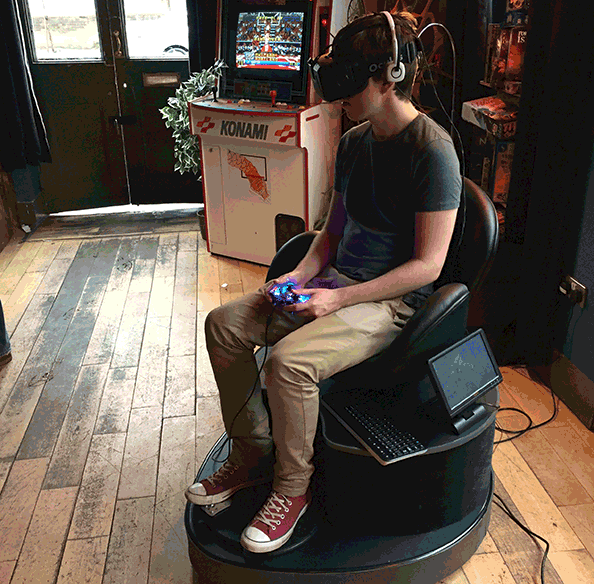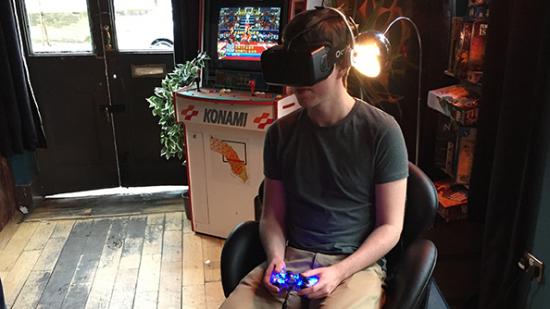Roto is an invention that aims to improve the experience of using a virtual reality headset by allowing full 360-degree turning using a special chair that rotates when you apply pressure to a pair of footpads. It operates on the notion that nobody should be allowed to stand up when using any kind of headset that teleports them to unknowable fantasy universes, lest they trip over a cable and die. It’s a solid notion and one that I approve of, having once knocked over a stack of Easter eggs while inside Oculus Rift.
Spinning around in a motorised office chair might be the future of virtual reality. It might also be something that isn’t the future of virtual reality. It might be a part of some version of one potential future of virtual reality. It might also be the case that virtual reality doesn’t have a future to be a part of. I honestly don’t know. I’m just a bit dizzy from all the spinning.
Here’s a bit more about how Roto works, before I talk about if it works.
The actual device is a motorised chair base that fits into most swivel-chair style seats. Attached to this base is a plate-shaped footpad that can be twisted left and right and control the chair’s rotation. Twist your feet to the left and the chair spins thataway. Twist them very slightly rightwards and the chair creeps clockwise. It’s subtle and comfortable, and in the version of the chair I played on all of the cables were wired into a PC mounted in the Roto’s base. So cable entanglement, which is a real problem with blinding VR headsets, wasn’t an issue.
Virtual reality’s biggest proponents, the Carmacks and the Palmer Luckeys, have maintained that the technology is supposed to be a seated experience. But sitting comes with obvious limitation on the scope of movement, narrowing a user’s cone of vision to a fairly limited space in front of their shoulders. Regular swivel chairs require some fancy footwork to diddle-daddle your way through 360 degree rotation, and produce the kinds of unnatural lateral motions that induce VR-nausea.
The most common control method in first-person VR experiences is even less natural, which is the use of a mouse or right thumbstick to turn the player around the virtual world while the player’s physical body sits still. This gives the unsettling feeling of the entire virtual world suddenly spinning around you, rather than the feeling that you’re turning around inside of it, and again this is almost immediately sickness-inducing.
So this magic chair abolishes that sort of artifical, right-thumbstick motion. To turn using Roto you act as you would in the real world: you look in the direction you intend to go, before turning your body to face that direction. To turn left down a corridor you point your entire body in that direction, rather than looking over your right shoulder as you would in a static chair for idiots. Roto addresses and fixes some real problems with virtual reality gaming.
Like all virtual reality equipment, you also look like a massive tool when you use it.

The night before I sat in the spinning virtual reality chair I had drank most of a bottle of Tesco’s finest sauvignon blanc. My breakfast was a cigarette, a diet coke and three egg bagels that the people from Roto had thoughtfully provided (cc gamergate). My body could not have been more unready to be teleported into a simulation of being in orbit high above the planet Earth, in which I could explode asteroids simply by staring at them.
Less ready was it for the sensation of turning around using Roto’s footpedals, which worked in some ways and didn’t in others. The system allieviated all of the usual VR-blindness anxieties you get about tangled cables and whether your physical body is about to step into and fall down a bottomless pit you hadn’t noticed before you put the VR goggles on. It felt much safer. It also felt quickly intuitive and easy to control.
It didn’t feel entirely natural however. Instead it felt like I was riding a motorised chair inside a virtual world, a kind of movement that definitely allowed you more freedom to explore in every direction, but a kind of movement that was still highly artificial. I played a brief section of Alien: Isolation. The chair was a really effective way of playing the game comfortably, but at no point did I ever forget I was atop a bizarre rotating seat.
Controlling Ripley felt like I was in charge of a toy tank, I was aware of whatever tracks and ball bearings were turning the chair beneath me as they whirred and span. I’ve been told that the seat’s speed setting was set to “moderate”, and at that speed the Roto felt sluggish. Even at the highest setting I’m sure the Roto comes nowhere close to real body turning speeds, and it certainly won’t be as quick as a flick of the mouse wrist, but for most VR experiences this shouldn’t be a problem. For the most part, games tailored for VR tend to give you little reason to turn around 180 degrees very quickly.
The inventors anticipate VR movies to be one of the primary uses of the tech however, and granting control over the direction a viewer is facing to an actual film director is one of the most exciting and tenable uses of the chair. So while spinning around inside the Nostromo all full of bagels, fags and wine might not have been the most pleasant experience, I can fully imagine a version of Roto being a hugely important asset to virtual reality film directors. Forcing the viewer to look at something in a 360-degree virtual space is a problem I’ve heard many developers mention in the past, and having control over the viewer’s swivel chair is a real solution that seemingly works.
The team plans to launch a Kickstarter on March 12th, with the basic product (the motorised base, sans additional table, camera, touchscreen and connectivity for different headsets) expected to cost below £200. You can find out more at the Roto website. Egg bagels were kindly provided by the Roto team.
